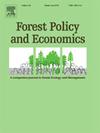Outsourcing stumpage price uncertainty with American put option for active timber management1
IF 4
2区 农林科学
Q1 ECONOMICS
引用次数: 0
Abstract
Stumpage price fluctuates all the time, creating price uncertainty for timberland owners and managers in making harvest decisions. As Chang and Zhang (2023) suggested, this price uncertainty could be outsourced with a rolling put option method, i.e., purchasing American put options needed every year to partially cover the stumpage price uncertainty. However, implementing rolling put options every year would be challenging in practice. In this paper, we devise a partial put option method to outsource such uncertainty with just one transaction. Specifically, we outsource stumpage price uncertainty with a partial American put option to determine the option values at different stand ages and calculate the corresponding reservation prices. As soon as the spot price exceeds the reservation price, the high stumpage price triggers an immediate timber harvest. The resulting harvest value and stand age are then incorporated into the generalized Faustmann formula to determine the corresponding land expectation value. Our simulations indicate that, compared to being passive stumpage price takers who ignore the price uncertainty, timberland owners could realize better financial performance with our method. In addition, they could choose the coverage level of partial American put option which suits their own risk preferences to balance uncertainty and return. Once timberland owners start actively selecting the strike price, the overall length of the option, and the level of partial option coverage, they are no longer price takers. Instead, they become price setters. That would bring about a sea change in the stumpage market with profound implications for timber supply and social welfare.
利用美式看跌期权外包立木采伐价的不确定性,实现积极的木材管理1
立木价格一直在波动,给林地所有者和管理者的采伐决策带来了价格不确定性。正如 Chang 和 Zhang(2023 年)所建议的,这种价格不确定性可以通过滚动看跌期权法来解决,即每年购买所需的美式看跌期权,以部分覆盖立木价格的不确定性。然而,每年实施滚动看跌期权在实践中具有挑战性。在本文中,我们设计了一种部分看跌期权方法,只需一次交易即可外包这种不确定性。具体来说,我们通过部分美式看跌期权来确定不同树龄下的期权价值,并计算相应的保留价,从而外包立木价格的不确定性。一旦现货价格超过保留价,高立木价格就会立即触发木材采伐。采伐价值和林龄随后被纳入广义福斯特曼公式,以确定相应的土地期望值。我们的模拟结果表明,与忽视价格不确定性的立木采伐价格被动接受者相比,林地所有者可以利用我们的方法实现更好的财务业绩。此外,他们还可以根据自己的风险偏好选择部分美式看跌期权的覆盖水平,以平衡不确定性和收益。一旦林地所有者开始主动选择行权价、期权的总长度和部分期权的覆盖水平,他们就不再是价格的接受者,而是价格的制定者。相反,他们将成为价格制定者。这将给立木市场带来翻天覆地的变化,对木材供应和社会福利产生深远影响。
本文章由计算机程序翻译,如有差异,请以英文原文为准。
求助全文
约1分钟内获得全文
求助全文
来源期刊

Forest Policy and Economics
农林科学-林学
CiteScore
9.00
自引率
7.50%
发文量
148
审稿时长
21.9 weeks
期刊介绍:
Forest Policy and Economics is a leading scientific journal that publishes peer-reviewed policy and economics research relating to forests, forested landscapes, forest-related industries, and other forest-relevant land uses. It also welcomes contributions from other social sciences and humanities perspectives that make clear theoretical, conceptual and methodological contributions to the existing state-of-the-art literature on forests and related land use systems. These disciplines include, but are not limited to, sociology, anthropology, human geography, history, jurisprudence, planning, development studies, and psychology research on forests. Forest Policy and Economics is global in scope and publishes multiple article types of high scientific standard. Acceptance for publication is subject to a double-blind peer-review process.
 求助内容:
求助内容: 应助结果提醒方式:
应助结果提醒方式:


